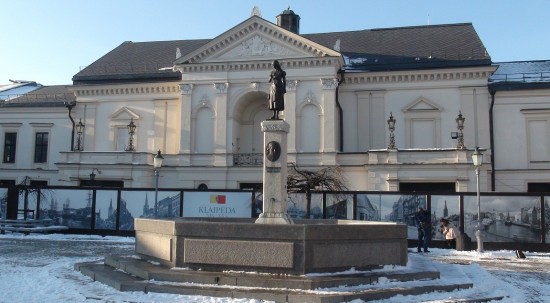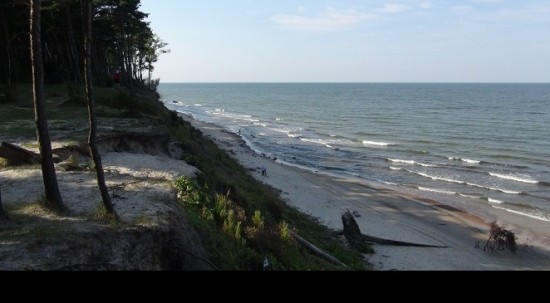Weekend in Klaipėda: Top 10 Sights & Experiences
Klaipėda is the Lithuania's only seaside city, unique for its German history.
Whereas you are a cruise ship passenger on a day-long stop or a tourist taking a short detour from other parts of Lithuania, there will be enough ways to spend your time in Klaipėda.
1. Explore the small Old Town: Theater square, Tiltų street, Danė river embankment. Sip a drink and eat dinner in its numerous calm restaurants.
2. Walk the Lagoon embankment and breakwater in Smiltynė with old romantic villas, a fisherman's farmstead, explorable 20th-century fishing vessels and nice views of the port. A short ferry ride will be necessary to get there.
3. Imbibe yourself with 19th-century German architecture in Liepų street of the New Town.
4. Visit the Lithuanian Sea Museum (Smiltynė) for sea animals, dolphin shows and information on Lithuanian shipping, all presented in a 19th-century German fortress.
5. Visit the museum of Lithuania Minor (Old Town), presenting the regional history and pre-WW2 diorama of Klaipėda.
6. Imagine the rich pre-WW2 city by printing out some old images and comparing them with what you see today. Much remains but some pretty buildings (such as the historic churches) unfortunately have been torn down by the Soviets.
7. Visit the small-but-modern museum in Castle ruins (Old Town) to be briefed on the city's history. If it's summer be sure to check if there are no events in the surrounding ex-industrial lands and docks.
8. Witness how the swing bridge (Old Town) is manually rotated by a couple of dockworkers and how yachts and small ships then pour from castle moat into the Danė river and vice-versa.
9. Check the Klaipėda University campus (New Town) located in a massive former barracks.
10. Sunbath at the surprising northern beaches of Klaipėda. You have a choice to either lie under a shade of WW2 military installation, at a constantly eroded Olando Kepurė cliff or within the traditional gender-segregated naturist sections (pre-dating Western naturism by far and considered uncivilized by the foreign diplomats of early 20th century).
Full online travel guide to Klaipėda
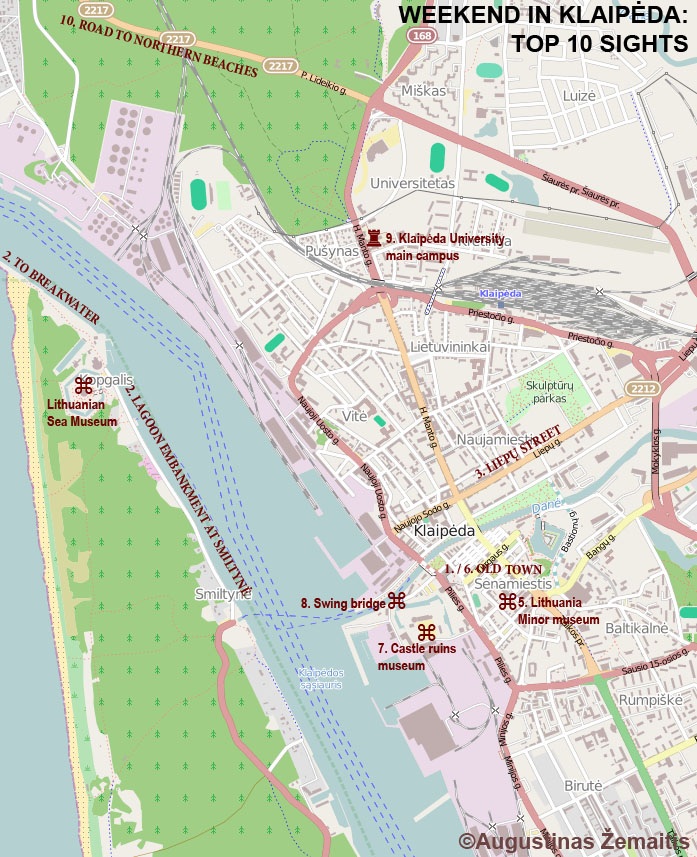
Map of the top 10 Klaipėda tourist sights. ©Augustinas Žemaitis.
History of Klaipėda (Memel)
The city ruled by German states (1250-1918)
Klaipėda was established on an empty shore by the Teutonic Knights in the 1250s. Invited by the Duke of Masovia to convert or destroy pagan Baltic tribes the Order chose this place for its castle. They called it Memelburg. Memel is the German name for Nemunas river and the early settlers mistakenly believed that the straits linking Curonian lagoon to Baltic Sea are in fact the mouths of that mighty river.
Around the castle, a town of primarily German craftsmen sprung up. The castle itself was constantly upgraded and managed to withstand all the wars against Lithuania leaving Klaipėda and its immediate surroundings the only area of modern Lithuania that has never been ruled by any Lithuanian state until the 20th century.
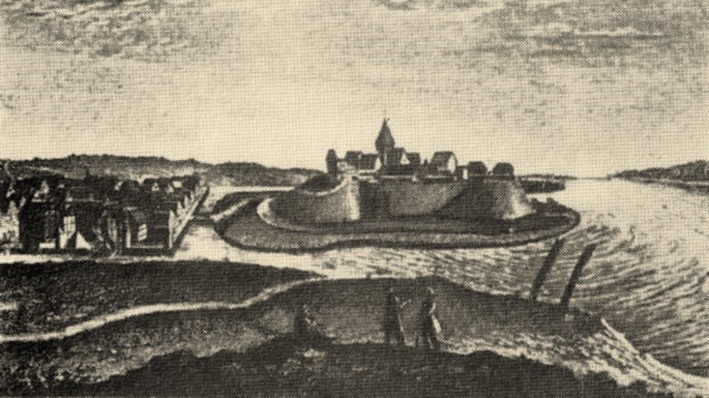

Klaipėda in the 16th century when it consisted of a castle (right) and a small town (left).
The agricultural countryside remained predominantly ethnic Lithuanian through ages and the Lithuanian name for the city "Klaipėda" was thus born in the 16th century as a pejorative, literally meaning "Bread eater" and referring to the castle garrison. The region was considered to be part of Lithuania Minor. With the secularization of the local branch of Teutonic Order (1525) Klaipėda (Memel) became part of Prussia's "Lithuanian kreises". During the Napoleonic wars, it even briefly held the status of Prussia's capital as the royal family retreated here from danger (1807-1808).
The 19th century brought growth (5000 to 20000 people), even if hampered by the dangers of Russia's proximity. To the likes of Richard Wagner or Heinrich Schliemann Klaipėda was a temporary career step. Others (among them more and more Lithuanian ex-villagers) arrived for good, however, staffing the burgeoning trade and lumber industries. It was lumber what fuelled the devastating fire of 1854 which caused 2/3 of the city to be rebuilt.
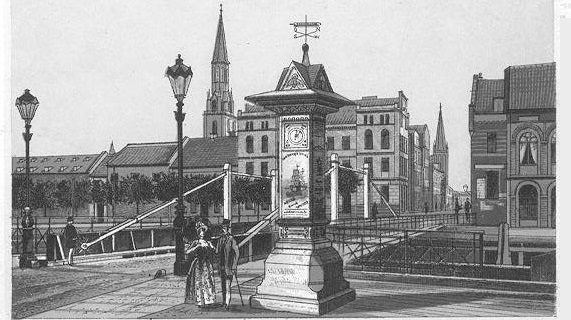

A sketch of the Klaipėda Old Town in 1880 after it has risen from ashes. Towering churches of different denominations and ethnicities reflected the diversity of a frontier merchant city.
Klaipėda region and Lithuania between the wars (1918-1945)
After Germany‘s loss of World War 1 its non-German areas were annexed to other countries, such as Denmark or Poland. While Klaipėda city's population of 45 000 was 70% German, its more populous surroundings were 70% Lithuanian, therefore the entire region had a slight Lithuanian majority and was detached from the German state. Lithuanian state was however not yet born as the Western powers were reluctant to recognize it due to its disputes in the east. Therefore the Klaipėda region was left to be ruled by the League of Nations.
Lithuania received wide international recognition by 1922. The status of Klaipėda region changed in 1923 when a Lithuanian-supported revolt took place and the region was captured by the Supreme Salvation Committee of Lithuania Minor that asked to be accepted into the Republic of Lithuania. All the nations recognized the annexation of Klaipėda but only as an autonomous territory where German and Lithuanian languages would enjoy equal status.


The New Town bank of Danė river with the Market of Klaipėda (left) and the Market (Biržos) Bridge. This is just one of many important buildings demolished by the Soviets after the war. Atgimimo square (New Town borough) was laid in this place.
The autonomy was established but this did not solve every problem. With the rise of Nazism in Germany in 1930s, this ideology became popular among Klaipėda's German population as well. This led to acts of terror and subsequent arrests of the local Nazi groups. In fact, this clampdown against national socialist organizations was the first anti-nazi trial to take place anywhere in Europe after the rise of Hitler (later it was nicknamed "Little Nuremberg").
Germany, a former ally of Lithuania, started pressuring Lithuania for a return of the Klaipėda region. This culminated in 1939 March when Germany annexed the region after an ultimatum, very similar to the one presented to Czechoslovakia for Sudetenland. Adolf Hitler himself then visited Klaipėda.
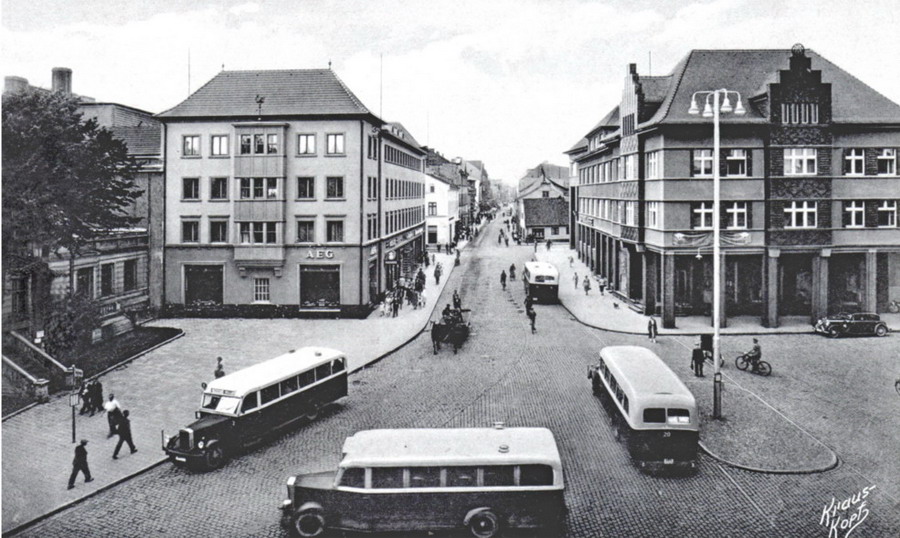

Buses and new buildings in interwar Klaipėda (modern Herkaus Manto street). Technologically advanced and more Western in its culture, Klaipėda had a profoundly different feel than other Lithuanian cities in the 1930s as it was the only one not to have suffered Russian Imperial regime.
After the World War 2 (1945 and beyond)
The history of old Klaipėda/Memel ended in 1945 when the city had been overrun by Soviet armies in late World War 2. The invading soldiers found only 20 inhabitants left in the city. Others, both Germans and Lithuanians, swiftly evacuated after hearing of Soviet massacres elsewhere. Klaipėda was then repopulated by Russians in the late 1940s. Since the 1950s, the Russians were joined by Lithuanians from other parts of the country. In 1950 Klaipėda became more populous than it was before World War 2 (~50 000 people), in some 1962 it was already double that size.
The total change of population was coupled with the devastation of Klaipėda old town. Soviets decided to demolish all the city's major churches. Many houses in the Old Town and especially the New Town were destroyed as well during the 1940s and 1950s Sovietization of the city. These changes left Klaipėda without some of its original character that once made it unique among Lithuania's cities. People of Klaipėda usually have little connection with the history of their city as their parents or grandparents moved in from somewhere else - some from Samogitian villages, some others from Moscow or Saint Petersburg. So the history now may only be seen in old bricks and sporadic attempts to recreate it by adopting historical names for shops and services. Much of this is to appease German tourists who still make a large share of Klaipėda's visitors.


The demolition of the fire department HQ in 1981 was the last of the historical building demolitions in Klaipėda. On the left a Soviet propaganda poster declares: Our work is for thee, oh Fatherland. ©Albinas Stubra.
After Lithuania‘s independence, Klaipėda became the second city in terms of foreign investments (yielding only to Vilnius). The first free economic zone in the country was quick to attract industry from as far away as Japan while the port continued to be a major impetus for economics.
Largest completed projects of the era include a gas terminal, "Akropolis" mall (once the largest in Baltics), arena (where matches of Eurobasket 2011 took place), major roads and more.


The project of Gandrališkės residential district of 2008. While it was scaled down after the economic downturn, tallest-in-Baltics residential tower has been constructed
Getting To and From Klaipėda
Klaipėda can be reached by car from Vilnius in 3 hours and 4 hours by express bus. A four-lane highway connects the city to Kaunas and Vilnius as well as Palanga. Another option of traveling to/from Kaunas is by the scenic Panemunė road via Šilutė.
Interesting locations around Klaipėda include Neringa and Palanga resorts. Both may be accessed by frequent buses: Palanga buses depart from the bus station while Neringa ones stop at the Smiltynė Old Ferry terminal (you have to take the ferry by yourself before boarding the bus).
Passenger trains leave Klaipėda station for Vilnius and Radviliškis. Both of these routes have intermediate stops in various towns, among them Kretinga, Telšiai, Plungė, and Šiauliai. The route to Vilnius also stops at Kėdaniai. The route to Šiauliai is more or less direct whereas the route to Vilnius is 100 km longer than the highway route and thus it takes 4-5 hours to go there by train.
Klaipėda has no passenger airport but Palanga airport some 30 kilometers to the north effectively serves Klaipėda as well. It is even branded as "Palanga/Klaipeda" in the timetables of some airlines. Air services from Palanga are limited, however, to just a few destinations. The rest of the European cities might be reached with transfers. Still, transfer flights originating in Palanga may be ~40% more expensive than similar flights from Vilnius, Kaunas, or Riga (some 2, 3, and 4 hours away by car, respectively), where the competition is tighter.
Being Lithuania's only seaport, Klaipėda may also be reached by ferries from Germany and Sweden. The ferries are overnight and transport cars as well as passengers. Cruise ships visit Klaipėda in summer (some also in spring and autumn) as a part of a longer Baltic cruise. However, Klaipėda is a less popular cruise port than those of Estonia and Latvia, likely because Klaipėda is not the capital.
The ferries dock in Southern Klaipėda while the cruise ships mostly dock in Old Town although some dock at Southern Klaipėda.


Container vessel in the port of Klaipėda. ©Augustinas Žemaitis.
Getting around Klaipėda: cars, public transport
Klaipėda Old Town is very small and many of its streets are effectively pedestrianized. Therefore, it would not be logical to use any form of transport there. If you'd go to the New Town, however, the distances become somewhat larger and beyond that (Seaside Klaipėda and Soviet districts) a car or public transport is essential.
Klaipėda is a car-friendly city where traffic jams are rare. The parking is rather cheap and paid in the Old Town (higher rate), New Town (lower rate) and near the beaches in Seaside Klaipėda. Elsewhere, the parking is free.
The only comprehensible public transportation in Klaipėda are buses. Generally, they go to all the districts and many suburbs.
The only area of Klaipėda where the buses don't go is Smiltynė beyond the Curonian Lagoon. It can be reached only by a ferry from either the Old Town "Senoji perkėla" (passenger-only) or the Soviet Districts "Naujoji perkėla" (cars and passengers). In Smiltynė, it is advisable to either walk or use a bike; the distances may be long but the forest paths are generally pleasurable.
A passenger ferry ride from Smiltynė to the Klaipėda Old Town. ©Augustinas Žemaitis.
Klaipėda cruise port: what to do
Klaipėda became a regular port for Baltic cruises, albeit not one of the most popular ones. Still, Klaipėda offers a large array of sights in or around it. There are several possible directions you could explore.
If you want to spend your day in Klaipėda sightseeing, here are the best ideas how to use your ~7 free hours in Klaipėda port. Pick one, as you won't have time to do several of them.
1.Traverse the Curonian Spit. Skip Klaipėda itself altogether and go to explore the Lithuania's (and maybe Eastern Baltic's) most famous natural sights, the "Lithuanian Sahara" of traveling sand dunes. It is possible to do on your own, as the passenger ferry to the Curonian Spit is frequent and it stops next to the main cruise port. Once on the Spit, there are hourly buses that traverse the entire peninsula. Key stops include the Nagliai Nature reserve (you need to ask the driver to let you off there), Juodkrantė resort and Nida resort with its breathtaking Parnidis dune. A short hike on dunes in Nagliai reserve and some time in Nida would likely be the best-spent time in the Curonian Spit, although to feel less time pressure you may also go directly to Nida and just spend several hours there. Nida is 50 km south of Klaipėda, so plan your time to get back accordingly.
2.Spend the day in Smiltynė. Smiltynė is the northernmost tip of the Curonian spit where the ferry from Klaipėda Old Town arrives. After crossing the lagoon by ferry (see above) you should not board any bus, but instead, explore the area on foot. Officially it is part in Klaipėda, though those forested shores seem a world apart. Smiltynė includes Klaipėda's best beaches, some old buildings and the Sea Museum with its dolphinarium (with regular dolphin shows), sea animal zoo and Lithuanian shipping exhibits. You may also watch modern ships coming and going into the Klaipėda port from the breakwater.
3.Explore Klaipėda on foot. Although the city has been ravaged by the Soviets with nearly all of its churches destroyed, the Old Town and 19th-century New Town are still picturesque. The city is unique as it has been developed by two cultures, its population consisting of Lithuanians and Germans for a long time. The key sights include the Theater Square, Castle remains and Tiltų street in the Old Town, as well as Liepų street in the 19th century New Town. More somber sights are the Museum of Lithuania Minor and the Soviet-destroyed Lutheran Cemetery, both testaments to how the Klaipėda of the old was destroyed in the Soviet genocide of the 1940s and repopulated by people from elsewhere. You may also shop at the Akropolis mall.
4.Go to Palanga. Take a walk from the ship to the Klaipėda bus station and take one of the every-15-minutes buses to Palanga, the Lithuania's "summer capital" and primary resort. There, you can visit not only the long sandy (often crowded) beaches, but also the Lithuania's top Amber museum with a collection of amber jewelry, pieces of amber with prehistoric animals/insects, and more. The museum is located in a former Tiškevičius family palace and surrounded by one of the Lithuania's prettiest parks. A walk to the end of the sea bridge is another must to the visitors of its resort, while architecture buffs may search for pretty wooden villas from the 19th-century era when count Tiškevičius has established the resort.
5.Explore the northern seaside of Klaipėda. First, go through the New Town to Klaipėda University. From there, you can take an hourly city bus (number 24) to the northern suburbs. In these suburbs, there are several resorts, such as the historic Giruliai resort which also has the remains of Nazi Germany defensive battery on the beach. The main natural landmark is the Olando Kepurė cliff near the northern end of the bus route.
Note: the suggestions there assume that your cruise ship would stop at the main cruise port in the Old Town Klaipėda. Some cruise ships dock further south.
Entertainment and Recreation in Klaipėda
As a seaside city, Klaipėda has much of its entertainment related to the sea. Beaches are popular in summer, with the best ones in Smiltynė. Angling and other water activities are also popular at the Curonian Lagoon.
That said, being the Western Lithuania's largest city Klaipėda also offers many other types of fun. Nightlife is mostly located in or around Klaipėda Old Town.
Pleasure ships moored at castle anchorage in summer. Like every summer, travelling funfairs come to Lithuanian seaside ©Augustinas Žemaitis.
Klaipėda Old Town and its immediate surroundings also host the city's two theaters: musical theater and drama theater. Both perform in Lithuanian but the musical performances should be easier to understand for foreigners.
New entertainment buildings have been largely constructed in Southern Klaipėda and require a long walk, a drive or a bus ride from downtown. They include Akropolis mall (which hosts the Klaipėda's only modern cinema and ice rink) and Švyturys arena (the main venue for gala concerts and basketball games of local "Neptūnas" team).
Football games (team "Atlantas") are played at a stadium north of New Town.
For those preferring a calm stroll to active entertainment Seaside Klaipėda has the most to offer. Consisting of massive pine forests and shorelines with just a few buildings here and there it is among the best locations for walking and bike-riding in the entire urban Lithuania. Smiltynė neighborhood (accessible by ferry) also offers Dolphinarium shows, best enjoyed by kids.
A dolphin show in Klaipėda dolphinarium. ©Augustinas Žemaitis.
All the Lithuanian seaside resorts are located less than 50 km from downtown Klaipėda. As such, in summer it may advisable to seek entertainment and recreation there. Palanga excels in its nightlife (at Basanavičiaus street), gigs and fun but it can get crowded. Neringa offers a much calmer, cleaner and somewhat more expensive fare of pretty landscapes, forests, and emptier beaches. Additionally, many weekends are festival weekends somewhere on the Lithuanian seaside.
Festivals and Celebrations in Lithuanian Seaside
In summer the spotlight of all Lithuanian life moves to the Seaside. Klaipėda, Palanga, and the Curonian spit become the stages for many major events, celebrations and gigs.
Many summer weekends have a weekend-long annual celebration going on somewhere in the Seaside, with tens of thousands (or hundreds of thousands) inland dwellers attending and participating. Many events are sea-related (dedicated to shipping, fishing) but there are also modern musical festivals. Seeking to become a year-round resort Palanga has successfully established some festival weekends outside season.
Sea festival regatta in Klaipėda, one of many sea-related events. ©Augustinas Žemaitis.
A drawback is that many of these annual events lack a specified date meaning that every year they move in time a little. There are approximate dates however and you may Google up the exact weekend the year you visit. Moreover, pre-booking a hotel may be essential in some celebration weekends.
List of annual celebrations and events
These are just the more famous events. Additionally, every resort has a "Season opening" (May) and a "Season closure" (September) weekend. There are also many non-annual fests at the main venues or right on the beach. Among the more interesting venues is the Klaipėda Musical Ferry that offers concerts while sailing in the Lagoon.
| Name | Date | Location | Event |
| Palanga smelt holiday | Mid-February weekend | Palanga | Entire Basanavičiaus high street is turned into a large open-air restaurant for smelts in this culinary/fishing holiday. If you prefer catching a smelt yourself, you may do so at the Sea Bridge where there are angling contests. Or you may swim in the cold sea yourself with a group of “health fanatics”. |
The smelt holiday brings shards of summer lifestyle into deep winter with Palanga resort getting crowded, its visitors eating outdoors and some swimming in the sea. ©Augustinas Žemaitis.
| Name | Date | Location | Event |
| Ship parade and regatta | Third Saturday of May | Klaipėda | The start of summer is marked by a parade of ships in the Curonian Lagoon and a massive firework. A regatta takes place the same day. |
| Benai, plaukiam į Nidą | Final weekend of May | Nida (Curonian Spit) | The oldest summertime seaside musical festival in Lithuania (est. 1994) offers open-air concerts of different musical styles. |
| Lagoon region fisherman’s holiday (Pamario krašto žvejo šventė) | Mid-July weekend | Juodkrantė (Curonian Spit) | Fishermen from all over the lagoon meet up in Juodkrantė showing off their livelihood/art to thousands of tourists and letting them taste traditional fish recipes. Now they may be a minority but before the 20th century, everybody in Juodkrantė used fishing for subsistence. |
| Thomas Mann festival | Third week of July | Nida (Curonian Spit) | The Curonian Spit was ruled by Germany prior to World War 1 and even after becoming Lithuanian it used to be favored by German artists and writers. Thomas Mann spent a couple of summers there and the art festival named after him includes concerts and fairs held all over Nida. |
| 1000 km race | Late July weekend | Palanga | Lithuania’s prime road race attracts many international teams. There are few limitations: old stock cars, Lamborghinis, buggies, and formulas all drive the same circuit. Trackside events include concerts a line-up of racecars in central Palanga prior to the race. The circuit is established by secluding a part of a highway. |


The cars line up next to Palanga main square for the annual 1000 km race (July). Spyker car is in the foreground. The race is followed by many publicity events and is well reported by the Lithuanian media. ©Augustinas Žemaitis.
| Name | Date | Location | Event |
| Nida Jazz marathon | Final weekend of July | Nida (Curonian Spit) | A festival that brings international jazz to atmospheric spaces of Nida (old Lutheran church to a pier). |
| Sea Festival | Late July-Early August (one weekend) | Klaipėda | The main festival of Klaipėda with its roots in 1934 when it was started to promote Lithuania as a naval country. Currently, it attracts hundreds of thousand people from all over Lithuania. There are concerts, parades, fireworks and other events typically located near the sea or the lagoon, while some key ceremonies are directly related to the sea. |
| Palanga Table (Palangos stalas) | Late September weekend | Palanga | A long table spans across Basanavičiaus street full of various meals. A great emphasis is put on healthy foods in this culinary festival. |
| Autumn equinox | September 20th-22nd | Juodkrantė (Curonian Spit) | In this ceremony hay sculptures (crafted by artists that Spring) are set on fire in Juodkrantė Bay, symbolizing the defeat of Pagan gods. |
